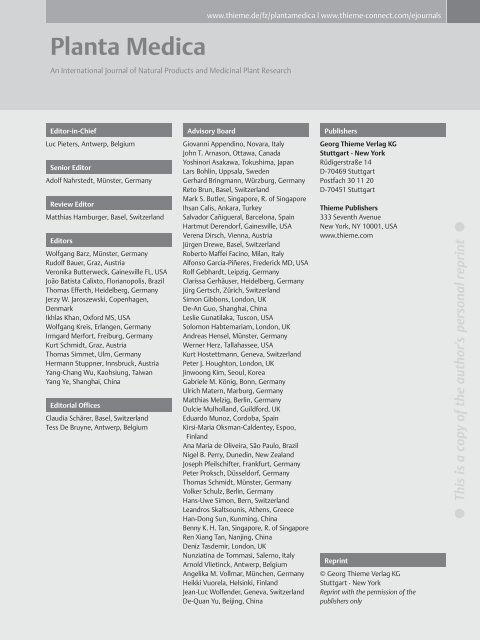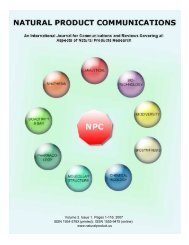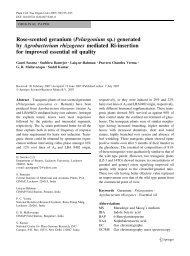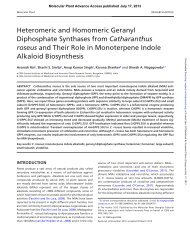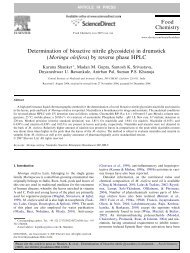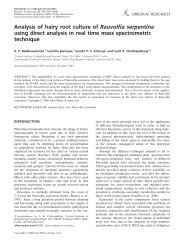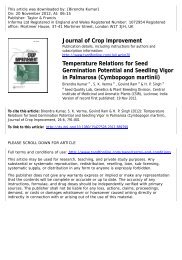Dinesh Kumar Agrawal, Dharmendra Saikia, Richa ... - CIMAP Staff
Dinesh Kumar Agrawal, Dharmendra Saikia, Richa ... - CIMAP Staff
Dinesh Kumar Agrawal, Dharmendra Saikia, Richa ... - CIMAP Staff
You also want an ePaper? Increase the reach of your titles
YUMPU automatically turns print PDFs into web optimized ePapers that Google loves.
Planta MedicaAn International Journal of Natural Products and Medicinal Plant Researchwww.thieme.de/fz/plantamedica l www.thieme-connect.com/ejournalsEditor-in-ChiefLuc Pieters, Antwerp, BelgiumAdvisory BoardGiovanni Appendino, Novara, ItalyJohn T. Arnason, Ottawa, CanadaYoshinori Asakawa, Tokushima, JapanLars Bohlin, Uppsala, SwedenGerhard Bringmann, Würzburg, GermanyReto Brun, Basel, SwitzerlandMark S. Butler, Singapore, R. of SingaporeIhsan Calis, Ankara, TurkeySalvador Cañigueral, Barcelona, SpainHartmut Derendorf, Gainesville, USAVerena Dirsch, Vienna, AustriaJürgen Drewe, Basel, SwitzerlandRoberto Maffei Facino, Milan, ItalyAlfonso Garcia-Piñeres, Frederick MD, USARolf Gebhardt, Leipzig, GermanyClarissa Gerhäuser, Heidelberg, GermanyJürg Gertsch, Zürich, SwitzerlandSimon Gibbons, London, UKDe-An Guo, Shanghai, ChinaLeslie Gunatilaka, Tuscon, USASolomon Habtemariam, London, UKAndreas Hensel, Münster, GermanyWerner Herz, Tallahassee, USAKurt Hostettmann, Geneva, SwitzerlandPeter J. Houghton, London, UKJinwoong Kim, Seoul, KoreaGabriele M. König, Bonn, GermanyUlrich Matern, Marburg, GermanyMatthias Melzig, Berlin, GermanyDulcie Mulholland, Guildford, UKEduardo Munoz, Cordoba, SpainKirsi-Maria Oksman-Caldentey, Espoo,FinlandAna Maria de Oliveira, São Paulo, BrazilNigel B. Perry, Dunedin, New ZealandJoseph Pfeilschifter, Frankfurt, GermanyPeter Proksch, Düsseldorf, GermanyThomas Schmidt, Münster, GermanyVolker Schulz, Berlin, GermanyHans-Uwe Simon, Bern, SwitzerlandLeandros Skaltsounis, Athens, GreeceHan-Dong Sun, Kunming, ChinaBenny K. H. Tan, Singapore, R. of SingaporeRen Xiang Tan, Nanjing, ChinaDeniz Tasdemir, London, UKNunziatina de Tommasi, Salerno, ItalyArnold Vlietinck, Antwerp, BelgiumAngelika M. Vollmar, München, GermanyHeikki Vuorela, Helsinki, FinlandJean-Luc Wolfender, Geneva, SwitzerlandDe-Quan Yu, Beijing, ChinaPublishersGeorg Thieme Verlag KGStuttgart · New YorkRüdigerstraße 14D-70469 StuttgartPostfach 30 11 20D-70451 StuttgartSenior EditorAdolf Nahrstedt, Münster, GermanyReview EditorMatthias Hamburger, Basel, SwitzerlandEditorsWolfgang Barz, Münster, GermanyRudolf Bauer, Graz, AustriaVeronika Butterweck, Gainesville FL, USAJoão Batista Calixto, Florianopolis, BrazilThomas Efferth, Heidelberg, GermanyJerzy W. Jaroszewski, Copenhagen,DenmarkIkhlas Khan, Oxford MS, USAWolfgang Kreis, Erlangen, GermanyIrmgard Merfort, Freiburg, GermanyKurt Schmidt, Graz, AustriaThomas Simmet, Ulm, GermanyHermann Stuppner, Innsbruck, AustriaYang-Chang Wu, Kaohsiung, TaiwanYang Ye, Shanghai, ChinaEditorial OfficesClaudia Schärer, Basel, SwitzerlandTess De Bruyne, Antwerp, BelgiumThieme Publishers333 Seventh AvenueNew York, NY 10001, USAwww.thieme.comReprint© Georg Thieme Verlag KGStuttgart · New YorkReprint with the permission of thepublishers only● This is a copy of the author's personal reprint ●
1828LetterDemethoxycurcumin and itsSemisynthetic Analogues asAntitubercular Agents<strong>Dinesh</strong> <strong>Kumar</strong> <strong>Agrawal</strong> 1 , <strong>Dharmendra</strong> <strong>Saikia</strong> 2 , <strong>Richa</strong> Tiwari 2 ,Shweta Ojha 2 , Karuna Shanker 1 , Jonnala Kotesh <strong>Kumar</strong> 1 ,Anil <strong>Kumar</strong> Gupta 2 , Sudeep Tandon 3 , Arvind Singh Negi 1 ,Suman Preet Singh Khanuja 21 Analytical Chemistry Division, Central Institute of Medicinal andAromatic Plants (<strong>CIMAP</strong>-CSIR), Lucknow, India2 Genetic Resources and Biotechnology Division, Central Instituteof Medicinal and Aromatic Plants (<strong>CIMAP</strong>-CSIR), Lucknow, India3 Process Division, Central Institute of Medicinal and AromaticPlants (<strong>CIMAP</strong>-CSIR), Lucknow, IndiaAbstract!Demethoxycurcumin, isolated from the rhizomes of Curcumalonga, was found to possess antitubercular activity againstMycobacterium tuberculosis H 37 Rv strain at 200 μg/mL. Derivatisationof this active principle yielded a potent agent 6, exhibitingconsiderable activity with a minimum inhibitory concentration(MIC) value of 7.8 μg/mL.Key words!Curcuma longa · Zingiberaceae · Mycobacterium tuberculosis ·demethoxycurcumin · phenolic derivatives · antitubercularactivityAbbreviations!H 37 Rv: Mycobacterium tuberculosis H 37 Rv strainMIC: minimum inhibitory concentrationSupporting information available online athttp://www.thieme-connect.de/ejournals/toc/plantamedicaTurmeric (Curcuma longa L.) has been used in the Indian system ofmedicine for the treatment of coughs, fever, jaundice, liver, urinarydiseases, wounds, inflammatory troubles of the joints and others[1]. Various medicinal properties of turmeric like antioxidant,anticancer, antimalarial, hepatoprotective, anti-inflammatory andwound healing are scientifically well established now [2].The present study was intended to identify the antitubercularprinciple from C. longa chloroform extracts. Of the three compoundsisolated, i. e., curcumin 1, demethoxycurcumin 2 and bisdemethoxycurcumin3, we could identify 2 as the compound responsiblefor the antitubercular activity in the extracts. This paperis the first report on demethoxycurcumin as an antitubercularagent. Furthermore, semisynthetic modifications of demethoxycurcuminyielded an analogue with an antitubercular activitytwenty five times higher than that of the parent.The chloroform extract of rhizomes showed antitubercular activityagainst H 37 Rv at 1000 μg/mL while the purified curcuminoid,demethoxycurcumin 2, was found to be active at 200 μg/mL (● " Table 1 and ● " Fig. 1). Demethoxycurcumin 2 was chemicallymodified at its phenolic hydroxy positions to get four dif-● This is a copy of the author's personal reprint ●Letter… Planta Med 2008; 74: 1828–1831
Letter 1829ferent derivatives 4 –7. Compound 6 possessed potent antitubercularactivity (MIC = 7.812 μg/mL), while 7 showed moderate activity(MIC = 125 μg/mL) (● " Table 1 and ● " Fig. 2). Compounds 1,3, 4 and 5 were inactive even at 250 μg/mL. In its 1 H-NMR spectrum,compound 6 showed a broad doublet at δ 4.68 (OCH 2 × 2), adoublet at δ 6.05 ( = CH × 2), a multiplet at δ 6.35 ( = CH × 2), atriplet at δ 0.96 ( = CH × 2) and a distorted quartet at δ 4.1(OCH 2 × 2) indicating attachment of two –OCH 2 -CH = CH-COOCH 2 CH 3 units at the phenolic positions. Electrospray massspectrometry confirmed its molecular formula as C 32 H 33 O 9 . The1 H-NMR spectrum of compound 7 exhibited two distinct singletsat δ 4.68 (OCH 2 ), δ 4.74 (OCH 2 ), a broad triplet at δ 1.33(CH 3 × 2) and a distorted quartet at δ 4.28 (OCH 2 × 2) to indicateattachment of the –OCH 2 COOCH 2 CH 3 units at the phenolic positions.Electrospray mass spectrometry confirmed its molecularformula as C 28 H 30 O 9 . The purities of the semi-synthetic derivatives6 and 7 were 94.7 % and 96.2 %, respectively.The objective of the synthesis of 6 and 7 was to increase the lipophilicityof 2 by attaching fatty acid ester chains at the phenolichydroxy groups. Earlier studies, [3], [4], [5], [6] foundthat molecules with moderate to high lipophilicity exhibit betterantitubercular activity due to the lipophilic nature of theMycobacterium tuberculosis cell wall. Therefore, transport of polarcompounds through the outer lipid layer of mycobacteria isretarded [7]. Fitzpatrick [8] reported antitubercular activity inaqueous extracts of C. longa leaves in broth dilution assays atMIC < 1 :40 dilution. In the tube dilution test, Grange and Davey[9] found the 95 % ethanolic extract of C. longa to be active at1 :80 dilution against H 37 Rv. Schraufstatter and Bernt [10] reportedcurcumin's antimycobacterial activity at 1:10 000 dilution.Table 1 Antimycobacterial activity of C. longa extract, curcuminoids andsemisynthetic derivatives against M. tuberculosis H 37 Rv strain with the BACTECassay.S. No. Compound MIC (μg/mL)1. Chloroform extract 10002. Curcumin (1) Inactive3. Demethoxycurcumin (2) 2004. Bisdemethoxycurcumin (3) Inactive5. 4 Inactive6. 5 Inactive7. 6 7.8128. 7 1259. Rifampicin 2.0Mean of three experiments in replicates.Fig. 1 Structures of curcumin 1, demethoxycurcumin 2 and bisdemethoxycurcumin3.Fig. 2 Determination of MIC (μg/mL) of extract and active constituentsagainst M. tuberculosis H 37 Rv strain with the BACTEC assay.But no further studies have been undertaken thereafter to identifythe molecule responsible. Thus, the present article is the firstreport on antimycobacterial activity of demethoxycurcumin 2.The curcuminoid content was determined in chloroform, acetonitrile,ethanol and ethyl acetate extracts of one and two year oldrhizomes of C. longa using analytical HPLC. It was observed thatthe concentrations of 1, 2 and 3 were higher in the two year oldrhizomes (chloroform extract – 118%, acetonitrile extract – 24 %,ethanol extract – 54 % and ethylacetate extract – 37 % higher) ascompared to the corresponding one year old rhizome extracts.The purities of isolated compounds 1, 2 and 3 were found to be99.4 %, 98.8 % and 98.6 %, respectively.In conclusion, the present study provides scientific support forthe traditional use of C. longa against various infections and fever.In some previous reports, the antimycobacterial activity ofC. longa was reported at extract level only. Now, demethoxycurcuminhas been found as a lead molecule for antitubercular activity.Two of its semisynthetic derivatives possessed better activity.Its structure-activity relationship (SAR) is under study,which may further support optimisation of a better antituberculardrug candidate in the future.Materials and Methods!The rhizomes of C. longa (family: Zingiberaceae) were collectedfrom <strong>CIMAP</strong> research farm, Lucknow (Accession No. <strong>CIMAP</strong>-1554) in October, 2006. The plant was authenticated by a <strong>CIMAP</strong>taxonomist. The rhizomes were dried at room temperature (25 –35°C), pulverised and stored at 10–15°C until extraction.Mycobacterium tuberculosis H 37 Rv (ATCC 27294) culture was obtainedfrom National JALMA Institute for Leprosy and otherMycobacterial Diseases, Agra, India.Ground rhizomes (145 g) were extracted with chloroform(1000 mL) after defatting with hexane in a Soxhlet apparatus toget 5.22 g of a residue. The residue (5.1 g) was chromatographedon silica gel (180 g, 60 – 120 mesh, 5 × 70 cm glass) and was elutedwith increasing polarity mixtures of hexane-chloroform andchloroform-acetone to get curcumin 1, demethoxycurcumin 2and bisdemethoxycurcumin 3 in 0.69 %, 0.09 % and 0.17 % yields.The isolated compounds 1, 2 and 3 were characterised by spectroscopy(see Supporting Information for spectra) [11], [12].Quantification of 1, 2 and 3 in the rhizome extracts was done byreverse phase HPLC (Waters) using a C-18 column (Symmetry;● This is a copy of the author's personal reprint ●Letter… Planta Med 2008; 74: 1828– 1831
1830LetterFig. 3 Modification of 2 into 4, 5, 6 and 7.Table 2Physical and spectral data of semisynthetic derivatives 4 – 7 of demethoxycurcumin.Compd. No. State Yield (%) 1 H NMR (300 MHz, CDCl 3 ) ESI Mass (MeOH)4 Oil 81 δ 2.31 (s, 6H, 2 ×OAc), 2.45 (s, 3H, OAc), 3.87 (s, 3H, OCH 3 ),6.23 (s, 1H, CO-CH = C-OH), 6.68 – 6.73 (d, 2H, = CH-CO-,J = 15.3 Hz), 6.76–6.82 (m, 4H, aromatic protons), 7.03–7.07(m, 1H, aromatic proton), 7.52–7.59 (m, 2H, aromatic protons),8.08– 8.13 (d, 2H, CH = C-CO-, J = 15.9 Hz).5 Oil 76 δ 3.76 (s, 3H, OCH 3 ), 3.85 (s, 3H, OCH 3 ), 3.96 (s, 3H, OCH 3 ),5.80 (s, 1H, CO-CH = C-OH), 6.47– 6.52 (d, 2H, = CH-CO-,J = 15.9 Hz), 6.86– 6.89 (d, 2H, aromatic protons, J = 8.4 Hz),6.90–6.93 (d, 2H, aromatic protons, J = 8.7 Hz), 7.07 (d, 1H,aromatic proton, J = 1.5 Hz), 7.13–7.15 (d, 1H, aromatic proton,J = 8.4 Hz), 7.49– 7.54 (d, 2H, CH = C-CO, J = 15.9 Hz),7.58–7.60 (d, 1H, aromatic proton, J = 6.0 Hz), 7.63– 7.65 (d,1H, aromatic proton, J = 6.0 Hz).6 Oil 67 δ 0.95 – 0.97 (t, 6H, 2 ×CH 3 ), 3.81 (s, 3H, OCH 3 ), 4.1 (distortedquartet, 4H, OCH 2 -C), 4.68 (bd, 2H, OCH 2 -C = ), 5.68 (s, 1H,CO-CH = C-OH), 6.03– 6.08 (d, 2H, 2× = CH-CO, J = 12.9 Hz),6.35–6.41 (d, 2H, 2× = CH-CO, J = 15.9 Hz), 6.65–6.67 (d,1H, aromatic proton, J = 6.0 Hz), 6.97 (bs, 1H, aromatic proton),7.05–7.08 (bs, 2H, 2×CH = ), 7.37–7.40 (d, 2H, aromaticprotons, J = 8.4 Hz), 7.49– 7.52 (d, 2H, aromatic protons,J = 7.5 Hz), 7.4– 7.7 (d, 1H, aromatic proton) ), 7.69–7.72 (d, 2H, CH = C-CO-, J = 15.9 Hz).7 Oil 79 δ 1.31– 1.34 (bt, 6H, 2 ×CH 3 ), 3.96 (s, 3H, OCH 3 ), 4.25– 4.31(bq, 4H, 2×OCH 2 -C), 4.68 (s, 2H, OCH 2 ), 4.74 (s, 2H, OCH 2 ),5.82 (s, 1H, CO-CH = C-OH), 6.50– 6.55 (d, 2H, 2× = CH-CO-,J = 15.6 Hz), 6.80– 6.83 (d, 1H, aromatic proton, J = 8.7 Hz),6.93–6.96 (d, 2H, aromatic proton, J = 8.7 Hz), 7.12– 7.13 (m,3H, aromatic protons), 7.51– 7.54 (d, 1H, aromatic protons,J = 8.7 Hz), 7.58– 7.63 (d, 2H, CH = C-CO-, J = 15.9 Hz).Positive mode: 487.0 [M + Na] + ,502.9 [M + K] + ; Negative mode:462.9 [M – 1] – .367.1 [M + Na] + .563.0 [M + H] + , 585.1 [M + Na] + ;Negative ESI: 560.8 [M – 1] – .511.1 [M + H] + , 533.1 [M + Na] + .● This is a copy of the author's personal reprint ●250 × 4.6 mm) and acetonitrile (5 % THF): 0.1 M NaHPO 4 (pH3.8) = 57:43 as mobile phase (buffer) with a flow rate of 1.0 mL/min. Data acquisition was done at 425 nm. Retention times (t R )of 1, 2 and 3 were 13.65, 12.25 and 10.98 min, respectively.Demethoxycurcumin 2 was modified into triacetate 4, dimethoxyether 5 and also to two novel lipophilic analogues, i. e., 4-{4-[7-(3-methoxy-4-methylphenyl)-3,5-dioxohepta-1,6-dienyl]-phenoxy}-but-2-enoicacid ethyl ester 6 and {4-[7-(4-ethoxycarbonylmethoxy-3-methoxyphenyl)-3,5-dioxohepta-1,6-di-enyl]-phenoxy}-acetic acid ethyl ester 7 at both its phenolic positions(● " Fig. 3) [13]. The structures of 4 – 7 were confirmed byspectroscopy (● " Table 2). All compounds 1 – 7 were evaluatedfor in vitro antitubercular activity with the BACTEC 460 RadiometricSusceptibility Assay (a detailed protocol is provided inthe Supporting Information) against Mycobacterium tuberculosisH 37 Rv (ATCC 27294). Rifampicin (Sigma Biochemicals; 95% pure)was used as positive control.Letter… Planta Med 2008; 74: 1828–1831
Letter 1831Supporting information1 H-, 13 C-NMR and mass spectra of compound 1 – 3 and a detailedbioassay description are available as Supporting Information.Acknowledgements!The authors are thankful to the Director, National JALMA Institutefor Leprosy and other Mycobacterial Diseases (ICMR), Agra, Indiafor providing the mycobacterial strain. DKA is grateful to the Director,Dr. K. N. M. I. P. E. R. Modinagar for her support and guidance.The authors are also thankful to Dr. Tanveer Khadija, Principal,CCG Degree College, Lucknow for improving the language ofthis paper. The financial support from the Council of Scientificand Industrial Research (CSIR), India is duly acknowledged.References1 Kapoor LD. Handbook of Ayurvedic Medicinal Plants. Boca Raton: CRCPress; 1990: 149 – 502 Gilani AH, Shah AJ, Ghayur MN, Majeed K. Pharmacological basis forthe use of turmeric in gastrointestinal and respiratory disorders. LifeSci 2005; 76: 3089 – 1053 Lu T, Cantrell CL, Robbs SL, Franzblau SG, Fischer NH. Antimycobacterialmatricaria esters and lactones from Astereae species. Planta Med1998; 64: 665 – 74 Rajab MS, Cantrell CL, Franzblau SG, Fischer NH. Antimycobacterial activityof (E)-phytol and derivatives: a preliminary structure-activitystudy. Planta Med 1998; 64: 2 – 45 Fischer NH, Lu T, Cantrell CL, Castaneda-Acosta J, Quijano L, Franzblau SG.Antimycobacterail evaluation of germacranolides in honour of ProfessorG. H. Neil Towers 75th Birthday. Phytochemistry 1998; 49: 559–646 Barry III CE, Slayden RA, Sampson AE, Lee RE. Use of genomics and combinatorialchemistry in the development of new antimycobacterialdrugs. Biochem Pharmacol 2000; 59: 221 – 317 Connell ND, Nikaido H. Membrane permeability and transport inMycobacterium tuberculosis. In: Bloom BR, editor. Tuberculosis, pathogenesis,protection and control. Washington DC: ASM Press; 1994: 333 – 518 Fitzpatrick FK. Plant substances active against Mycobacteriumtuberculosis. Antibiot Chemother 1954; 4: 528 – 369 Grange JM, Davey RW. Detection of antituberculous activity in plantextracts. J Appl Bacteriol 1990; 68: 587 – 9110 Schraufstatter E, Bernt H. Antibacterial action of curcumin and relatedcompounds. Nature 1949; 164: 456 – 711 Anderson AM, Mitchell MS, Mohan RS. Isolation of curcumin from turmeric.J Chem Educ 2000; 77: 359 – 6012 Govindarajan V. Turmeric – chemistry, technology and quality. BocaRaton: CRC Press; 1980: 3 – 1213 Furniss BS, Hannaford AJ, Smith PWG, Tatchell AR. Vogel's textbook ofpractical organic chemistry, 5th edition. London: Addison-WesleyLongman; 1998: 986received April 24, 2008revised August 28, 2008accepted August 31, 2008BibliographyDOI 10.1055/s-0028-1088335Planta Med 2008; 74: 1828–1831© Georg Thieme Verlag KG Stuttgart · New YorkPublished online November 7, 2008ISSN 0032-0943CorrespondenceDr. Arvind Singh NegiAnalytical Chemistry DivisionCentral Institute of Medicinal and Aromatic Plants (<strong>CIMAP</strong>-CSIR)Kukrail Picnic Spot RoadP. O. <strong>CIMAP</strong>Lucknow – 226015IndiaPhone: +91-522-2342676, Ext. 327Fax: +91-522-2342666arvindcimap@rediffmail.com● This is a copy of the author's personal reprint ●Letter… Planta Med 2008; 74: 1828– 1831


